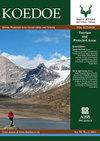南非克鲁格国家公园萨塔拉地区火操纵稀树草原的不同草食动物占用率
IF 1.1
4区 环境科学与生态学
Q3 BIODIVERSITY CONSERVATION
引用次数: 0
摘要
长期以来,火灾一直被认为是稀树草原生态系统中植被结构的重要决定因素(Sankaran & Hanan 2008:17),并且经常被保护主义者用作管理工具。在过去的一个世纪里,南部非洲火灾管理的变化反映了生态考虑水平的提高(Van Wilgen 2009:105),部分原因是通过诸如南非克鲁格国家公园(KNP)的实验燃烧地块(ebp)等操作的洞察力。这项火灾实验始于1954年(Biggs et al. 2003:46),并促进了稀树草原生态系统中火灾生态学的研究项目(Govender, Trollope & Van Wilgen 2006:43)。火灾范围、频率和烧伤形状影响野生动物在景观中的分布(cromsight, Archibald & Owen-Smith 2017:47;罗伯茨2008:1)。此外,空间上的斑块性火灾推动了食草动物的时空分布,特别是在火灾发生后立即聚集在斑块上(McGranahan & Kirkman 2013:176)。燃烧影响饲料的质量和数量,以及动物的行为和饮食(Roberts 2008:1)。火灾频率通过改变捕食风险进一步影响有蹄类动物的分布(Burkepile et al. 2013:139)。在景观尺度上,火灾减少了植物生物量(Hanan et al. 2008:171),导致食草动物暂时流离失所。火灾影响养分循环(Van der Vijver, Proot & Prins 1999:173)和土壤有机氮和碳(Holdo et al. 2009:115),它们影响克鲁格国家公园(KNP)长期实验燃烧地块(ebp)的研究项目历史,这些项目提高了对热带草原生态系统火灾的理解。利用KNP 2005-2016年的空中普查数据和2008-2017年的原位粪便计数数据,本研究评估了(1)Satara、N 'Wanetsi和Marheya ebp在年度、三年和无烧伤处理以及干旱前、期间和后气候条件下的食草动物密度;(2)这些ebp相对于其未被操纵的环境的食草动物密度;(3)与水和降雨的距离对有蹄类密度的影响程度。结果表明,三种不同处理间草食动物平均密度存在显著差异。N 'Wanetsi区密度最高(0.30只/ha), Marheya区密度最低(0.12只/ha)。总体而言,干旱前样地的密度较高(0.56只/ha),而干旱后样地的密度较高(0.80只/ha)。平均而言,在较大尺度上,ebp上的草食动物密度(2.54只/ha)显著高于周围基质(0.15只/ha)和中央KNP(0.18只/ha)。草食动物平均密度与离水距离呈正相关。然而,不同处理的食草动物平均密度与降雨量密切相关。本文章由计算机程序翻译,如有差异,请以英文原文为准。
Differential herbivore occupancy of fire-manipulated savannas in the Satara region of the Kruger National Park, South Africa
Fire has long been considered an essential determinant of vegetation structure in savanna ecosystems (Sankaran & Hanan 2008:17) and is frequently utilised as a management tool by conservationists. Changes in fire management in southern Africa over the past century reflect an increasing level of ecological consideration (Van Wilgen 2009:105), partially through the insight of manipulations such as the experimental burn plots (EBPs) in the Kruger National Park (KNP), South Africa. This fire experiment began in 1954 (Biggs et al. 2003:46) and has facilitated research projects on fire ecology in savanna ecosystems (Govender, Trollope & Van Wilgen 2006:43). Fire extent, frequency and burn shape influence wildlife distributions across landscapes (Cromsigt, Archibald & Owen-Smith 2017:47; Roberts 2008:1). Moreover, spatially patchy fire drives the spatial and temporal distribution of grazers, in particular, to congregate on immediate post-fire patches (McGranahan & Kirkman 2013:176). Burning affects forage quality and quantity as well as animal behaviour and diet (Roberts 2008:1). Fire frequency further influences ungulate distribution through altered predation risk (Burkepile et al. 2013:139). At a landscape scale, fire reduces plant biomass (Hanan et al. 2008:171), resulting in temporary displacement of herbivores. Fire affects nutrient cycling (Van der Vijver, Proot & Prins 1999:173) and soil organic nitrogen and carbon (Holdo et al. 2009:115), which influence The Kruger National Park’s (KNP) long-running experimental burn plots (EBPs) have a history of research projects, which improve the understanding of fire in savanna ecosystems. Using data from KNP’s aerial censuses (2005–2016) and in situ dung count data (2008–2017), this study assessed (1) herbivore densities on the Satara, N’Wanetsi and Marheya EBPs, on annual, triennial and no-burn treatments and across pre-, during and post-drought climate conditions; (2) herbivore densities of these EBPs relative to their non-manipulated surroundings and (3) the extent to which distance to water and rainfall influence ungulate densities. The results revealed that herbivore mean density differed significantly between the three EBPs of Satara and across their fire treatments. N’Wanetsi showed the highest density (0.30 animals/ha), whilst the lowest was found at Marheya (0.12 animals/ha). Overall, pre-drought density was higher on the annual plots (0.56 animals/ha), whilst higher post-drought density was evidenced on the triennial plots (0.80 animals/ha). On average, there were significantly higher herbivore densities on the EBPs (2.54 animals/ha) compared to the surrounding matrix at the larger scales of the Satara management section (0.15 animals/ha) and the central KNP (0.18 animals/ha). A positive correlation between herbivore mean density estimate and distance to water was shown. However, grazer mean density across fire treatments was strongly correlated to rainfall.
求助全文
通过发布文献求助,成功后即可免费获取论文全文。
去求助
来源期刊

Koedoe
BIODIVERSITY CONSERVATION-
CiteScore
3.30
自引率
0.00%
发文量
10
审稿时长
20 weeks
期刊介绍:
Koedoe, with the subtitle ''African Protected Area Conservation and Science'', promotes and contributes to the scientific (biological) and environmental (ecological and biodiversity) conservation practices of Africa by defining the key disciplines that will ensure the existence of a wide variety of plant and animal species in their natural environments (biological diversity) in Africa.
 求助内容:
求助内容: 应助结果提醒方式:
应助结果提醒方式:


